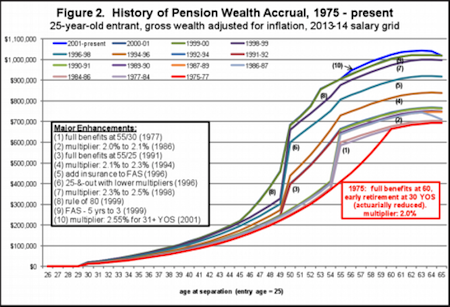The chart below may appear complicated, but it explains a lot about what’s happened over time to teacher pensions. It comes from a Show-Me Institute brief from Bob Costrell. Each line represents the pension wealth accrual (essentially a teacher’s annual pension multiplied by the number of years she can expect to receive it) for 25-year-old females at given points in time. The lines have been adjusted for inflation, and they use the current salary schedule for Jefferson City, Missouri.
The bottom line (in red) represents the pension plan offered to Missouri teachers in 1975. It was a fairly standard pension plan. Teachers did not qualify for any pension at all in their early years before “vesting” at five years, earned a relatively small pension for the next 10-15 years, and then accelerated toward a much higher peak at the back-end of their career. Back in 1975, that peak was at age 60 (it had been age 65 in 1967).

Over the years, and especially during the 1990s when the stock market was booming, legislators increased pension benefits significantly.* But they have not distributed those increases evenly to all teachers. There has been no change at all for teachers who serve for five years or less, which in Missouri is now about 42 percent of all teachers. And there have been comparatively small changes for Missouri teachers who serve for 15 or 20 years (about 2/3rds of the workforce).
The biggest changes have been near the back-end, for teachers with 25 or 30 years of experience. In inflation-adjusted terms, Missouri legislators have doubled or tripled the pensions of full-career teachers.
As the brief describes, these increases eventually came with a cost. Legislators raised teacher contributions to the pension plan from 8 percent of salary to 14.5 percent today. All Missouri teachers today pay those costs, even though the majority of them won’t benefit from the pension increases. In fact, a research paper earlier this year found that Missouri’s higher contribution rates more than offset any gains a new teacher might make from the pension enhancements. If you want to know why districts can’t afford to give base salary increases to early- and mid-career teachers, these type of pension enhancements are a big reason why.
*Note that the increases were retroactive, meaning a teacher who started in 1975 but retired in 2005 received not what she was promised when she started but the much higher benefit passed before she retired.
—Chad Aldeman
This post originally appeared on TeacherPensions.org.


